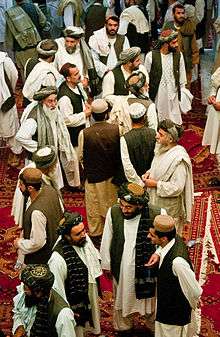Pakthas
Pakthas are an ancient people that find reference in Sanskrit and Greek sources as a people living in the region which includes south-eastern Afghanistan and Northern parts of Pakistan. In the Rigveda, the Kurram is mentioned as "Kruma". Pachytyans were in charge of all "elephants" used in battle fields. Elephant hoarders or boarders or they took care of elephants. Today, the Kurram Valley is mostly inhabited by the Bangash and Turi Pashtun tribes, and because of that the ancient Pakhtas are believed to be part of the modern-day Pashtun confederation.[1][2]
"The Pakthas, Bhalanases, Vishanins, Alinas, and Sivas were the five frontier tribes. The Pakthas lived in the hills from which the Kruma originates. Zimmer locates them in present-day eastern Afghanistan, identifying them with the modern Pakthun."[3]
Rigved Pakthas
 |
| Part of a series on |
| Pashtuns |
|---|
| Kingdoms |
| Religion |
The Pakthas were one of the tribes that fought against Sudas in the Dasarajna the Battle of the Ten Kings (dāśarājñá), a battle alluded to in Mandala 7 of the Rigveda (RV 7.18.7).[4]
Herodotus records Pactyans
Heinrich Zimmer connects them with a tribe already mentioned by Herodotus (Pactyans), and with Pashtuns in Afghanistan and Pakistan.[5][6] The Greek historian Herodotus mentioned a people called Pactyan living on the eastern frontier of the Achaemenid Arachosia Satrapy as early as the 1st millennium BCE.[7]
Gandhara Paktas
The area of the Gandhara has been associated with the Pakta or Pakthas.
"The description Gandhara can be found in the Rigveda and it is also known as the Peshawar valley and the people of the area were known as Paktha."[8]
See also
- Turvayana
- Rigvedic tribes
- Afghan (ethnonym)
- History of Pakistan
- Name of Afghanistan
- Arachosia
- Alexandria of the Arachosians
- Gandhari people
- Pre-Islamic scripts in Afghanistan
- Rigvedic rivers
References
- ↑ India: from Indus Valley civilisation to Mauryas By Gyan Swarup Gupta Published by Concept Publishing Company, 1999 ISBN 81-7022-763-1, ISBN 978-81-7022-763-2, page 199.
- ↑ Comrie, Bernard (1990). The World's Major Languages. Oxford University Press. p. 549.
- ↑ Ancient Pakistan: Volume 3, University of Peshawar. Dept. of Archaeology - 1967, Page 23
- ↑ p. 2 "Some Aspects of Ancient Indian Culture" By D. R. Bhandarkar
- ↑ Macdonell, A.A. and Keith, A.B. 1912. The Vedic Index of Names and Subjects.
- ↑ Map of the Median Empire, showing Pactyans territory in what is now Afghanistan and Pakistan...Link
- ↑ "The History of Herodotus Chapter 7, Written 440 B.C.E, Translated by George Rawlinson". Piney.com. Retrieved 2012-09-21.
- ↑ "Khudai khidmatgar and national movement: Momentous speeches of Badshah Khan" by Abdul Ghaffar Khan p. 238
- Encyclopaedia Indica, A contuining series, India Pakistan Bangladesh, Anmol Publications, Page 647, ISBN 81-7041-859-3
Further reading
- Dictionary of Vedanta by Samir Nath , Ivy Publishing House ISBN 81-7890-056-4